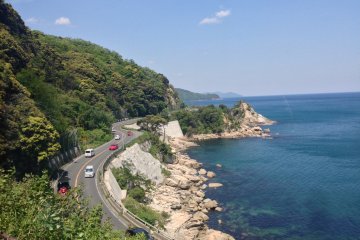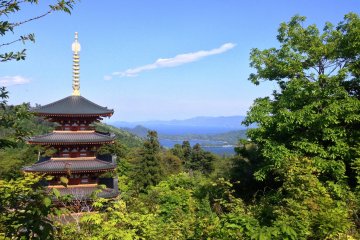Nestled between sea and mountains in northern Kyoto lies the scenic town of Kyotango—a serene coastal escape where tradition and nature live side by side.
For those seeking more than surface-level sightseeing, Tsunagaru Inc. presents a Journey of Encounters—a deeper kind of journey shaped by hands-on experiences, heartfelt conversations, and the quiet beauty of everyday craftsmanship. The very first destination on this meaningful journey is Kyotango. Here, what begins with beautiful views can soon open the door to the region’s living culture, where every experience tells a story and every meeting leaves a lasting impression.
Tourists to these parts have the chance to engage with master artisans: katana swordsmiths, craftspeople, and sake brewers who breathe life into centuries-old skills. In Kyotango, culture lives and breathes through shared stories, the rhythm of tools in motion, and the warmth of local hospitality. Here, you don’t just witness heritage—you feel it come alive through touch, taste, and meaningful connection. This town is proof that sometimes, a journey of encounters can quietly change your life.
Where Steel Meets Soul – The Art of the Katana
Among the highlights of our journey was a meeting steeped in fire and tradition—with master swordsmith Tomoki Kuromoto. Beneath the watchful silence of the forge, we stepped into the world of katana-making, where a single blade may take up to two years to complete. Here, red-hot steel is forged in flames exceeding 1,000°C and hammered repeatedly with painstaking precision. As Kuromoto-san began his live demonstration, the space filled with the rhythmic clang of steel on steel—a pulsing, ancient music that echoed through the air.

Some of us stepped forward, taking up the weighty hammer ourselves, only to realize the sheer physical strength and focus this craft demands. Later, inside the main residence, we saw completed swords gleaming with quiet power. As Kuromoto-san shared his personal story—the grueling path of apprenticeship, where a single misstep could mean expulsion—we began to see each blade not just as a weapon, but as a testament to resilience, patience, and generational spirit. In his hands, the katana became more than steel. It became a vessel of Japan’s living heritage.

A Flicker of Tradition with Hand-Crafted Lanterns
Next, we stepped into the soft glow of tradition with Syun Kojima, the tenth-generation head of Kojima Shoten, a lantern workshop whose roots stretch back to the Edo period (1603–1868). Once based in Kyoto City, Kojima-san chose a quieter life in Kyotango, drawn by the embrace of sea and mountains—a landscape that now shapes his craft.

Under his gentle guidance, we created our own “Chibimaru” lanterns, choosing from a palette of delicate washi papers in soft hues and intricate patterns. The process was slow and meditative, offering a window into tranquility. Each lantern, wrapped with care, became a reflection of its creator’s essence. When we lit them, they glowed not just with color, but with quiet personalities—no two the same, each offering a flicker of warmth and hinting at a story.


Savoring Tradition in Local Cuisine
Lunch brought us to “Torimatsu,” a cherished local gem known for its signature barazushi (colorful sushi decorated with fresh fish and seasonal vegetables). Served under the gentle hush of midday light, the dish surprised and delighted with its delicate layering of oboro (sweetened minced mackerel) in a true harmony of quintessentially Japanese flavors. As we dined, wide glass windows framed the quiet rhythm of rice fields swaying in the breeze. It was a moment of stillness, taste, and tranquility, offering a pause to savor before the journey continued.

A Passage into Sake Culture
Our final stop led us into the quiet heart of Yosano’s Kaya Valley, where Yosamusume Sake Brewery has stood since 1887. Greeted by Shiro Nishihara, the sixth-generation owner, we were drawn into a story steeped in devotion to sake, family, and the land that nourishes both. With pride and warmth, he spoke of his craft, while showing us the whimsical frog illustrations hand-painted by his wife—each bottle a labor of love.


We sipped from the source: soft, naturally filtered water flowing from granite-rich mountains, transformed into a range of sake—from dry and crisp to sweet and sparkling. Among the favorites was “Yosamusume Tokubetsu Junmai,” a smooth, comforting sake that Nishihara-san himself enjoys paired with dinner. Though the peak brewing season had just passed and the barrels were few, the air within the brewery held the rich, quiet fragrance of Japan’s ancient sake tradition.

Connecting with the Heart of Kyotango
As the sun dipped behind the horizon, casting a golden glow over our day in Kyotango, we found ourselves reflecting on what had become more than just a journey. We had crossed into something deeper. This wasn’t sightseeing; it was soul-seeing. We forged genuine connections, shared laughter and stories, learned from the hands of masters, and tasted the region’s spirit.
Now, it’s your turn to discover Kyotango’s hidden treasures. In meeting those who keep culture alive, in hearing their stories and touching their craft, your journey may unfold into something more than travel—something quietly transformative. And perhaps, like us, you’ll leave with more than memories. You’ll carry a piece of your Kyotango encounters in your heart.
















